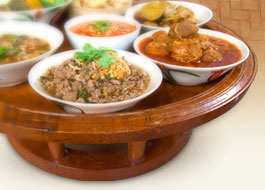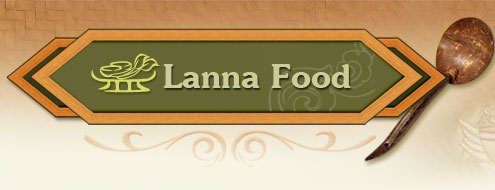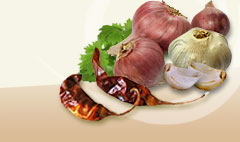Ma waeng |
|
|
 | Solanum indicum L. S |
|
| |
 | Solanaceae |
|
| |
 | Ba Khwaeng khom (Northern) (Bunchuen Chairat, 1999, p. 1345), ma waeng ton (Central), waeng khom (Surat Thani, Sonkhla), mak kheng khomm (Udon Thani, Roi Et, Northeastern), Sakang, khae (Karen-Mae Hong Son), mak kaeng Khong (Shan-Mae Hong Son). (Phennapha Sapcharoen and Kanchana Diwiset, eds., 1999, p. 178) |
|
| |
 | Shrub, 1-2 ft. high, woody stem, hairy with thorns, leaves ovate, lobate, hairy, 5-15 cm. long. Flowers axillary or terminal, ฝ inch wide. Berry round, smooth, white when young and orange-yellow when mature (Phennapha Sapcharoen and Kanchana Diwiset, eds., 1999, p. 178). Propagated by seeds. |
|
| |
 |

No information available on nutrition. Young fruit is eaten raw or blanched and roasted with namphrik (Kanchana Diwiset, et al., comp., 1999, p. 219). Lanna people put young fruit in yam tao (thao or fresh water algae). |

Stem can relieve effects of alcohol intoxication, diabetes, improve urination, treat bruises, improves blood circulation. Leaves are pulverized to put on wounds to stop bleeding, or prevent infection. Seeds are roasted to inhale the smoke to relieve a toothache (Bunchuen Chairat, 1999, p. 1345) Roots are pulverized to treat wounds or boiled to drink as an expectorant, its also used as a diuretic, to encourage movement of gas and relieve coughs as well as itchiness (Wut Wuthithamwet, 1997, p. 368) |
|
| |
 | All year round |
|
| |
 |
Kanchana Diwiset, et al., comp. (1999). Phak Phuen Ban Phak Klang. Kanchana Diwiset, ed. Nonthaburi: Project on Text Development of the Institute for Traditional Thai Medicine. (in thai). Bunchuen Chairat. (1999). Khwaeng Khom, Ba. inSaranukrom Wattanatham Thai Phak Nuea (Vol. 3, p. 1345). Bangkok: Siam Commercial Bank Foundation for the Encyclopedia of Thai Culture. (in thai). Phennapha Sapcharoen and Kanchana Diwiset, eds. (1999). Mai Rim Rua: Samunhrai Kap Wattanatham Thai Part 2. Nonthaburi: Institute of Traditional Thai Medicine. (in thai). Wut Wuthithamwet. (1997). Saranukrom Samunphrai: Ruam Lak Phesatchakam Thai. Bangkok: Odean Store. (in thai). (in thai). |
|
| |
|
|




